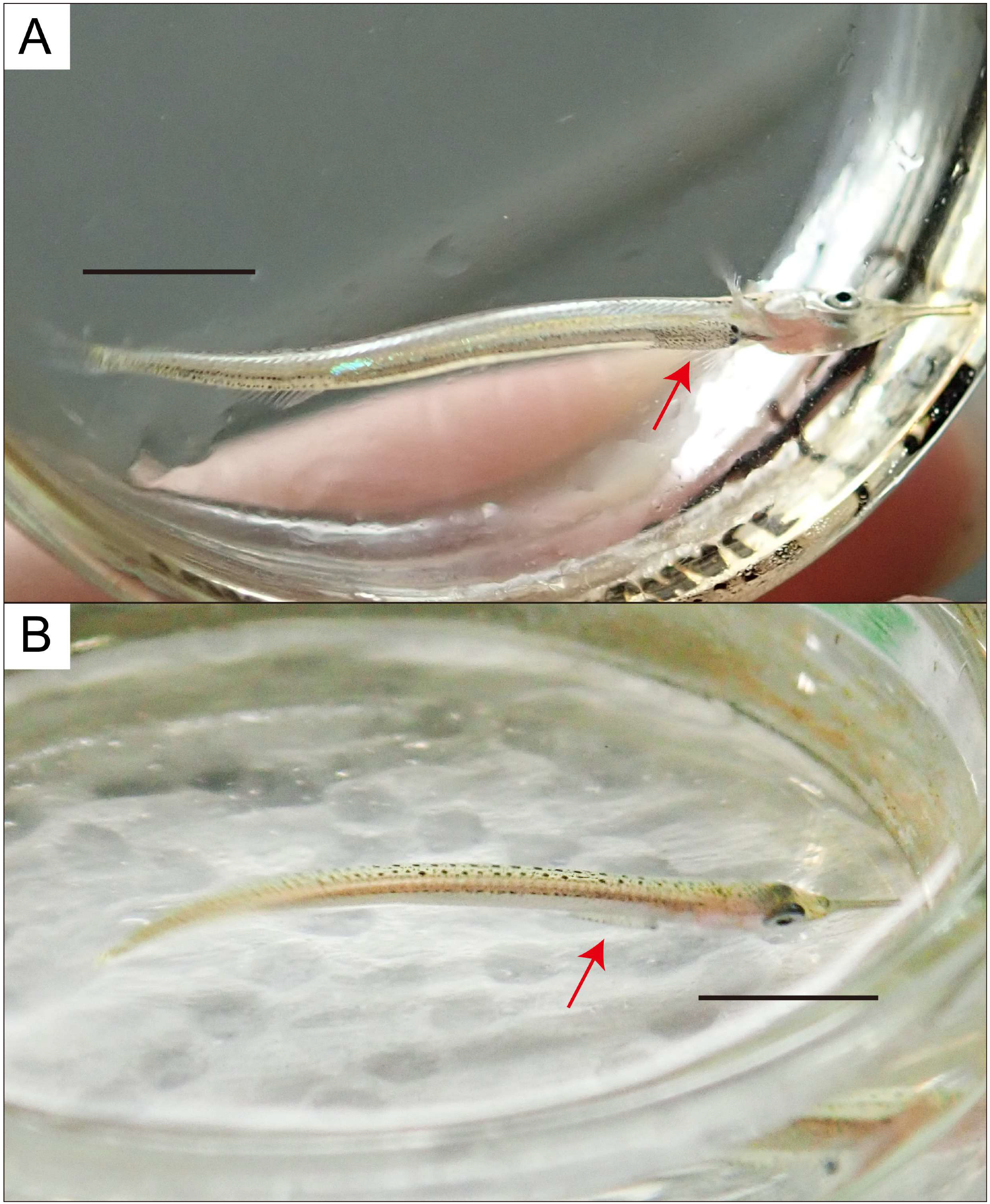Evidence for Initial Infestation by Mothocya parvostis (Isopoda: Cymothoidae) on Body Surface of Juvenile Japanese Halfbeak, Hyporhamphus sajori (Beloniformes: Hemiramphidae)
Abstract
Author Contributions
Funding
Institutional Review Board Statement
Data Availability Statement
Conflicts of Interest
References
- Bruce, N.L. Revision of the isopod crustacean genus Mothocya Costa, in Hope, 1851 (Cymothoidae, Flabellifera), parasitic on marine fishes. J. Nat. Hist. 1986, 20, 1089–1192. [Google Scholar] [CrossRef]
- Rajkumar, M.; Perumal, P.; Trilles, J.P. Cymothoa indica (Crustacea, Isopoda, Cymothoidae) parasitizes the cultured larvae of the Asian seabass Lates calcarifer under laboratory conditions. Dis. Aquat. Organ. 2005, 66, 87–90. [Google Scholar] [CrossRef] [PubMed]
- Inoue, M. On sexuality in Cymothoidae, Isopoda II Irona melanosticta Schoedte & Meinert parasitic in the branchial cavity of the halfbeak, Hyporhamphus sajori (Temminck & Schlegel). J. Sci. Hiroshima Univ. Ser. B 1941, 1, 219–238. [Google Scholar]
- Fujita, H.; Kawai, K.; Deville, D.; Umino, T. Molecular and morphological characterizations of the fish parasitic isopod Mothocya parvostis (Crustacea: Cymothoidae) parasitizing optional intermediate hosts: Juveniles of the cobaltcap silverside Hypoatherina tsurugae and yellowfin seabream Acanthopagrus latus. Zool. Stud. 2023, 62, e21. [Google Scholar] [CrossRef]
- Fujita, H.; Kawai, K.; Taniguchi, R.; Tomano, S.; Sanchez, G.; Kuramochi, T.; Umino, T. Infestation of the parasitic Isopod Mothocya parvostis on juveniles of the black sea bream Acanthopagrus schlegelii as an optional intermediate host in Hiroshima Bay. Zool. Sci. 2020, 37, 544–553. [Google Scholar] [CrossRef] [PubMed]
- Fujita, H.; Okumura, Y.; Shinoda, H. Ceratothoa arimae (Isopoda: Cymothoidae) infesting buccal cavity of largescale blackfish, Girella punctata (Centrarchiformes: Kyphosidae), in Seto Inland Sea, Japan. Fishes 2025, 10, e126. [Google Scholar] [CrossRef]
- Aneesh, P.T.; Kappalli, S.; Kottarathil, H.A.; Gopinathan, A.; Paul, T.J. Cymothoa frontalis, a cymothoid isopod parasitizing the belonid fish Strongylura strongylura from the Malabar Coast (Kerala, India): Redescription, description, prevalence and life cycle. Zool. Stud. 2015, 54, e42. [Google Scholar] [CrossRef]
- Aneesh, P.T.; Kappalli, S.; Kottarathil, H.A.; Gopinathan, A. Mothocya renardi (Bleeker, 1857) (Crustacea: Isopoda: Cymothoidae) parasitising Strongylura leiura (Bleeker) (Belonidae) off the Malabar coast of India: Redescription, occurrence and life-cycle. Syst. Parasitol. 2016, 93, 583–599. [Google Scholar] [CrossRef] [PubMed]
- Aneesh, P.T.; Sudha, K.; Helna, A.K.; Anilkumar, G. Agarna malayi Tiwari 1952 (Crustacea: Isopoda: Cymothoidae) parasitising the marine fish, Tenualosa toli (Clupeidae) from India: Re-description/description of parasite life cycle and patterns of occurrence. Zool. Stud. 2018, 57, e25. [Google Scholar] [CrossRef]
- Brusca, R.C. Studies on the cymothoid fish symbionts of the eastern Pacific (Isopoda, Cymothoidae) I. Biology of Nerocila californica. Crustaceana 1978, 34, 141–154. [Google Scholar] [CrossRef]
- Brusca, R.C. Studies on the cymothoid fish symbionts of the eastern Pacific (Crustacea: Isopoda: Cymothoidae). II Systematics and biology of Lironeca vulgaris Stimpson. Allan Hancock Found. Spec. Publ. New Ser. 1978, 2, 1–19. [Google Scholar]
- Brusca, R.C. A monograph on the Isopoda, Cymothoidae (Crustacea) of the eastern Pacific. Zool. J. Linn. Soc. 1981, 73, 117–199. [Google Scholar] [CrossRef]
- Hadfield, K.A.; Bruce, N.L.; Smit, N.J. Redescription of poorly known species of Ceratothoa Dana, 1852 (Crustacea, Isopoda, Cymothoidae), based on original type material. Zookeys 2016, 592, 39–91. [Google Scholar] [CrossRef] [PubMed]
- Smit, N.J.; Bruce, N.L.; Hadfield, K.A. Global diversity of fish parasitic isopod crustaceans of the family Cymothoidae. Int. J. Parasitol. Parasite Wildl. 2014, 3, 188–197. [Google Scholar] [CrossRef] [PubMed]
- Fujita, H.; Aneesh, P.T.; Kawai, K.; Kitamura, S.I.; Shimomura, M.; Umino, T.; Ohtsuka, S. Redescription and molecular characterization of Mothocya parvostis Bruce, 1986 (Crustacea: Isopoda: Cymothoidae) parasitic on Japanese halfbeak, Hyporhamphus sajori (Temminck & Schlegel, 1846) (Hemiramphidae) with Mothocya sajori Bruce, 1986 placed into synonymy. Zootaxa 2023, 5277, 259–286. [Google Scholar] [CrossRef] [PubMed]
- Kawanishi, R.; Sogabe, A.; Nishimoto, R.; Hata, H. Spatial variation in the parasitic isopod load of the Japanese halfbeak in western Japan. Dis. Aquat. Organ. 2016, 122, 13–19. [Google Scholar] [CrossRef] [PubMed]
- Kawai, K.; Fujita, H.; Sanchez, G.; Umino, T. Oyster farms are the main spawning grounds of the black sea bream Acanthopagrus schlegelii in Hiroshima Bay, Japan. PeerJ 2021, 9, e11475. [Google Scholar] [CrossRef] [PubMed]
- Fujita, H.; Kawai, K.; Deville, D.; Umino, T. Quatrefoil light traps for free-swimming stages of cymothoid parasitic isopods and seasonal variation in their species compositions in the Seto Inland Sea, Japan. Int. J. Parasitol. Parasite Wildl. 2023, 20, 12–19. [Google Scholar] [CrossRef] [PubMed]
- Fujita, H.; Kawai, K.; Shimomura, M.; Umino, T. “Lure fishing” strategies by Mothocya parvostis (Isopoda: Cymothoidae): Feeding behavior-mediated infestation on juveniles of black sea bream, Acanthopagrus schlegelii. Int. J. Parasitol. Parasite Wildl. 2025, 26, e101057. [Google Scholar] [CrossRef] [PubMed]
- Fujita, H.; Shinoda, H.; Okumura, Y. Description of life cycle stages of fish parasite Cymothoa pulchrum (Isopoda: Cymothoidae), with DNA barcode linked to morphological details. Fishes 2025, 10, e155. [Google Scholar] [CrossRef]



Disclaimer/Publisher’s Note: The statements, opinions and data contained in all publications are solely those of the individual author(s) and contributor(s) and not of MDPI and/or the editor(s). MDPI and/or the editor(s) disclaim responsibility for any injury to people or property resulting from any ideas, methods, instructions or products referred to in the content. |
© 2025 by the authors. Licensee MDPI, Basel, Switzerland. This article is an open access article distributed under the terms and conditions of the Creative Commons Attribution (CC BY) license (https://creativecommons.org/licenses/by/4.0/).
Share and Cite
Fujita, H.; Kawai, K. Evidence for Initial Infestation by Mothocya parvostis (Isopoda: Cymothoidae) on Body Surface of Juvenile Japanese Halfbeak, Hyporhamphus sajori (Beloniformes: Hemiramphidae). Diversity 2025, 17, 613. https://doi.org/10.3390/d17090613
Fujita H, Kawai K. Evidence for Initial Infestation by Mothocya parvostis (Isopoda: Cymothoidae) on Body Surface of Juvenile Japanese Halfbeak, Hyporhamphus sajori (Beloniformes: Hemiramphidae). Diversity. 2025; 17(9):613. https://doi.org/10.3390/d17090613
Chicago/Turabian StyleFujita, Hiroki, and Kentaro Kawai. 2025. "Evidence for Initial Infestation by Mothocya parvostis (Isopoda: Cymothoidae) on Body Surface of Juvenile Japanese Halfbeak, Hyporhamphus sajori (Beloniformes: Hemiramphidae)" Diversity 17, no. 9: 613. https://doi.org/10.3390/d17090613
APA StyleFujita, H., & Kawai, K. (2025). Evidence for Initial Infestation by Mothocya parvostis (Isopoda: Cymothoidae) on Body Surface of Juvenile Japanese Halfbeak, Hyporhamphus sajori (Beloniformes: Hemiramphidae). Diversity, 17(9), 613. https://doi.org/10.3390/d17090613






